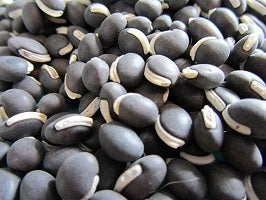Lablab Bean
Lablab Bean
Packet Size: 30 seeds
Couldn't load pickup availability
Say hello to the LabLab Bean, also known as the Hyacinth Bean – a stunning climbing plant that can shoot up to around 2 metres tall! Not only is it a feast for the eyes, but it’s edible too. The young pods can be picked early and cooked whole, or you can let them mature for sliced beans – or go the whole way and dry them for winter use. Handy, right?
The foliage has a lovely purple tinge, which gives the plant an ornamental flair, and the flowers? Oh, they’re something else – scented, and in surprise shades of purple, red, pink or white. You’ll just have to wait and see what colour pops up in your patch. It’s a great all-rounder – gorgeous and useful!
SOW & GROW: start these off in pots or modules, barely cover the seed, & place in an unheated greenhouse or on a windowsill during late April or May. This is a tender plant that doesn’t like cold soil or cold snaps. Plant out after hardening off when about 15cm tall after all frost danger has passed. Your Lablab plants will need tall canes for them to climb. To enjoy their perfume plant near a path. Water regularly during warm dry spells. Plants growing under glass like a humid atmosphere so damp the path every day. Any feed should be high Potassium and low/no nitrogen.
ENJOY: you can pick the young pods and cook them whole (steam or stir fry and we think this is the nicest stage to eat them). Leave them to mature for sliced beans (can be a bit tougher and stringy) or leave them even longer for dried beans: these need cooking thoroughly in several changes of water.
🌿 TOP TIP
Lablab Beans can get very leafy and lush but not produce many flowers (or any!) if the nitrogen levels are too high. These clever plants actually make their own nitrogen, so no need for nitrogen-rich fertiliser – too much can work against you.
If you’ve accidentally overdone it, don’t worry. You can balance things out by adding more potassium and phosphorus. A tomato feed is a great, easy option – just check the N:P:K numbers on the bottle. You’re after low N (nitrogen), medium to high P (phosphorus), and high K (potassium).
There are non-chemical ways of doing this – here are some options:
Banana Skins – Packed with potassium! You can compost them or steep them in water to make a gentle, natural feed. Great for flower power.
Food Waste Compost – General food scraps (especially fruit and veg peelings) tend to be higher in potassium. Just be mindful – composting cooked food or meat can attract unwanted visitors like rats, so keep it veggie-based.
Wood Ash – A traditional favourite. Wood ash from untreated wood is rich in potassium and can be added to your compost or sprinkled directly onto beds over autumn and winter. Let the rain and frost work it into the soil before planting time.
Greensand – A mineral-rich natural product that slowly releases potassium (and other goodies) into the soil. It’s gentle, organic, and great for long-term soil health.
Give your LabLab the right balance, and it’ll reward you with flowers, pods, and plenty of character in the garden. Happy growing!

Collapsible content
Sowing
- Apr
- May
- Jun

